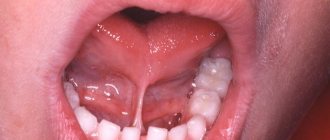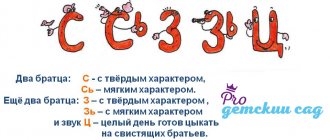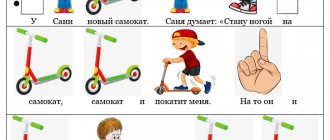How to teach a child to say letters without “swallowing” and to correctly pronounce the letters R and L?
If it is difficult for your child to pronounce R or L, then a special set of exercises to strengthen the muscles of the tongue, classes for the correct pronunciation of letters in syllables and syllables, as well as useful children's tongue twisters to improve diction will help solve this problem.
One of the most common problems that parents of preschoolers face is how to teach their child to pronounce letters correctly. Usually, for a very long time, children fail to correctly pronounce the “tricky” letters R and L. And in this article we will teach you step by step how to conduct classes with your child to improve diction and correct pronunciation of letters. After you carefully familiarize yourself with the methods that will help you teach your child to pronounce the letters r and l, the child may not need the help of a pediatric speech therapist at all.
The “difficult” letter P for most children remains resistant to mastering longer than all other letters. As a rule, problems with the correct pronunciation of the letter P appear at a time when the baby’s speech is just beginning to develop, at the stage of basic development. You cannot waste this time and put off learning how to pronounce letters correctly so that the child develops the skills to express his thoughts in well-delivered speech and so that burr does not take hold.
When teaching your child to correctly pronounce the letters R and L, it is important to organize classes correctly: Do not overtire the child, study with him no more than 15 minutes daily; Teaching the skills of correct pronunciation of letters should be organized in a playful way; The tone in the process of teaching a child should not be intrusive and must be friendly.
So, with the help of the 6 steps below, you can teach your child to pronounce the letter r correctly:
STEP ONE
Preparation for classes: facial massage
Before teaching your child to say letters correctly, we will give him a massage to warm up his facial muscles. The baby is facing you, his eyes are directly opposite yours. We do the massage and voice all the actions: Slowly and gently stroke the superciliary area of the baby’s forehead with warm fingertips and at the same time say: “This is how much we love ourselves, this is how reverently we love ourselves...” Then we begin to gently massage the wings of the nose and move our fingers in the direction of the maxillary sinuses sinuses, at the same time we say: “Oh, what a nice little nose we have, what a cute snub nose we have...” After this, smooth the baby’s skin around the cheekbones, lips, cheeks and up to the ears with massaging movements, and then in the opposite direction. Say at the same time: “Sponges, our lips, break into a smile! Our mouth is a mouth, it is not silent at all! Our ears are our ears, you are always on top!”
STEP TWO
Warm-up exercises
We have already given the baby a warming massage for the facial muscles. Let's start with the first exercises.
The child is still facing you, his posture is straight and his eyes are at the level of yours.
These exercises will help to thoroughly strengthen the baby’s tongue muscles and will contribute to the development of forced vibration of the very tip of the tongue.
Ask your baby to alternately touch the lower and upper teeth with the tip of his tongue (30-40 times).
Then the baby sharply slaps his tongue on the area of the palate, where the upper row of teeth is located, while pronouncing the letter D. Be sure to demonstrate all the actions so that the baby accurately performs the exercises.
Further. Ask your baby to stick out his tongue a little while keeping his lips closed. The child strongly pushes air out of his mouth, and by inertia the tip of the tongue should vibrate. In subsequent exercises, the baby will independently learn to reproduce this sound without pushing air out of his mouth.
STEP THREE
Basic exercises to improve tongue mobility and strengthen the skills of correctly pronouncing the letter r
* Now let’s introduce more game elements into training. Ask the child to show his tongue - let him relax it a little and wag it with a sound coming out between his teeth, as if teasing. Then arrange a competition with your baby to see which of you can stick out his tongue further.
* An excellent activity that will help your baby quickly learn to pronounce the letter P is to imitate the clatter of horse hooves, characteristically clicking your tongue. Teach your child to click his tongue and ask him to repeat these sounds fifteen times.
* How to learn to pronounce the letter r in a playful way using a proven method? An excellent exercise - the baby moves his thumb in different directions, placing it under the tongue. At the same time, the child tries to pronounce the letter P (growl like a running car engine).
* Another good exercise with which in a playful way you can master the correct pronunciation of the letter P and strengthen the muscles of the tongue. Ask your baby to show a smile by spreading his lips wider and using the tip of his tongue to “clean” the teeth, first from the outside and then from the inside. It is advisable to repeat the exercise 20-25 times. The lower jaw should not move.
STEP FOUR
How to teach a child to pronounce all letters, including R? We continue to strengthen the muscles of the tongue and develop its mobility.
– Ask the child to open his mouth wider and show his teeth. The sides of the tongue are located on the molars, and the tip is on the surface of the front teeth. Ask your child to make the tongue “strong” for ten seconds, and then relax for a while. Repeat the exercise with your baby (6-7 times).
– This exercise to strengthen the tongue muscles will be a little more difficult for the baby. But having mastered it, the child will quickly learn to pronounce the letters r and l correctly. The exercise is as follows - the baby seems to “suck” the surface of the tongue to the palate, and then “tears” it away from the palate with a characteristic click. We do this exercise ten times at a slow pace, then speed up and slow down again (a total of 30-35 repetitions at different paces).
– Now ask the child to slightly open his lips and lightly bite the tip of the tongue (15-20 repetitions)
– The final exercise to strengthen the muscles of the tongue - the baby blows air with force, while the tongue is between the lips. It is advisable to ensure that the tongue vibrates.
STEP FIVE
And now we move on from “physical education” exercises for the language to mastering the skills of correctly pronouncing the letter P in different syllables and short combinations.
First, rehearse with your child the skill of correctly pronouncing R in an open syllable - ro, ra. Then try to pronounce R with hard consonants - dr, tr. When the baby consolidates these skills, move on to learning how to correctly pronounce words (short ones known to the child) with these syllables. These exercises sharpen the technique of correct speech and help teach a child to pronounce the letter r.
STEP SIX
Children's tongue twisters for the development of speech and diction in a child.
If your child already knows how to pronounce the letter P quite well, but sometimes (during a conversation) he “chews” it or pronounces it incorrectly, then it’s time to introduce your child to tongue twisters.
Popular tongue twisters remarkably eliminate speech defects, relieve a child of tongue-tiedness, promote the development of skills in correct pronunciation of letters and words, and are considered the most effective method of “honing” the articulation of different sounds.
If your baby can already memorize short nursery rhymes, then you can start learning tongue twisters. But you need to learn tongue twisters by heart step by step - first, the baby repeats the tongue twister (after you) very slowly. In this case, the child must understand the meaning of the text being memorized. We gradually increase the pace of pronouncing the tongue twister, but you must correct articulation and diction. Below you will find the most suitable tongue twisters with which you can teach your child to pronounce letters, including the “complex” letter P:
5 EXERCISES WITH WHICH YOUR BABY WILL LEARN TO PRONUNCIATE THE LETTER L
Before you teach your child to say letters, do not forget that a preschooler learns the material more easily in a playful form of learning. Sometimes a baby does not pronounce the letter L correctly for quite a long time. There are effective exercises to solve this problem. The method is in many ways similar to practicing the skills of correct pronunciation of the letter P
It is advisable to perform each exercise for ten seconds 5-7 times. The whole complex - 3 times from start to finish step by step. (daily 2 times)
Exercise 1
We practice the skill of lifting the tongue up and strengthen the muscles of the tongue. Ask your child to show you his teeth with a wide smile. The child's tongue touches the palate and clicks, like a horse hooves on the asphalt.
Exercise 2
We “sharpen” the baby’s skill of making his tongue wide, developing the ability to quickly tense and relax the muscles of the tongue. Ask the child to open his mouth slightly and stick his tongue out far, and then place it on the lower lip with a wide edge. Ask your baby to hold his tongue in this position for 5 seconds.
Exercise 3
Now we teach the child to exhale air in thin streams along the edges of the tongue. Opening his mouth slightly, the child lightly bites the tip of his tongue with his front teeth and begins to blow, increasing the pace and strength. Control the strength and direction of the air stream using a light feather (don’t forget about the play element in teaching a small child)
Exercise 4
We practice the baby’s skill of quickly changing the position of the tongue. This exercise is necessary to strengthen the muscles of the tongue so that the baby can easily and quickly connect the letter L with different vowels - U, A, O, Y
the child opens his mouth slightly, presses the tip of his tongue firmly against the base of the upper teeth from the inside, and then quickly changes the position of the tongue, resting its tip against the base of the lower teeth. At first the exercise is performed slowly, then we speed up the pace.
Exercise 5
Now we move on to learning the correct pronunciation of the letter L in words and syllables. Words and syllables (lu-lu-lu-lu, la-la-la-la, lo-lo-lo-lo, la-lo-lu-la-lo-lu) are even better to sing rather than pronounce. After this, open a children's book with pictures, the objects in which contain the letter L in their names in different combinations with other letters. Let the child try to tell something about each object so that its name appears in every sentence.
Now you know how to correctly and quickly teach a child to pronounce “complex” letters, including the letters R and L. Let’s highlight 3 key points that form the foundation for developing a child’s pronunciation skills of different letters: exercises to strengthen the muscles of the tongue and its mobility , teaching a child the correct pronunciation of a particular letter in different syllables, learning tongue twisters and repeating them frequently (slowly-fastly). If your child does not succeed in something, do not move on to the next stage of training, but continue to practice skills in the exercises where you stopped.
Sound C - sound features
The correct pronunciation of the sound “S”: clench your teeth and stretch your lips a little. The tip of the tongue should be rested against the lower row of teeth, the middle of the tongue should be arched, and its lateral edges should be rested on the teeth.
The vocal cords are not involved, they rest, so the sound is considered dull.
The consonant “C” is whistling, hard, fricative, anterior-lingual.
You can read about the production of the sound “Z” in the next article.
Preparation of the articulatory apparatus
Doing various speech gymnastics is very important for a child. Examples of articulation exercises that are recommended to be performed in front of a mirror:
- make a fence of teeth and smile;
- blow on soap bubbles, cotton balls, fluff, floating toys in the water;
- whistle into sticks;
- make a “spatula”: the tongue lies in a wide position on the lower lip (hold for a few seconds);
- “tube” exercise: open your mouth and curl your tongue into a tube, then blow into it for a long time.
Helper fingers
Based on long-term observation of young children, experts have come to the conclusion that the development of fine motor skills keeps pace with the formation of speech skills. Finger exercises activate the parts of the brain that are responsible for speech.
Classes must begin from the first days after birth. And even though the baby is still far from his first words, the massage will well prepare his speech centers for conversation. Finger gymnastics for newborns consists of stroking, bending and straightening the fingers, and circular movements on a small palm.
The nursery rhyme game “Ladushki,” which everyone remembers well from childhood, will teach kids to straighten their fingers and coordinate movements by clapping their hands. Parents recite a funny poem during the game.
At 7 months, when the baby begins to sit, you can introduce him to paper. For example, give the baby an old book with color pictures. Children love to rustle paper, tear off pieces, and crumple it. Parents should take into account that most likely, only scraps will remain from the book.
Games with small objects are great for developing fingers:
- beads;
- cereal;
- buttons;
- peas.
Preschoolers enjoy putting together puzzles, sculpting from plasticine, cutting out paper figures, drawing and coloring pictures.
Sound production technique C
You can make the sound “C” in different ways:
- imitating;
- mechanically;
- with the help of articulatory gymnastics;
- using other sounds.
In order to make the sound “C” by imitation, you need to practice in front of a mirror and show your baby the correct position of the tongue and lips. The child should feel the cool exhaled air while pronouncing a consonant - put his palm to his mouth.
The mechanical method involves the use of auxiliary devices: a probe, a spatula. At home, a mild toothpick or ice cream stick is suitable for use.
Procedure:
- The object must be placed along the tongue, fixing its correct position for pronunciation.
- The child should smile and place the edge of the tongue on the lower incisors. You need to blow through the resulting gap.
- Pressing the object along the tongue forms a groove along which a stream of air flows. A whistle should be heard.
- The tongue should be hidden behind the teeth, and the teeth should be brought together.
- The child continues to whistle, and the parent (speech therapist) adjusts the pressure, achieving the correct and clear sound pronunciation of “C”.
- As soon as the sound begins to sound clearly, remove the mechanical object.
After several such trainings, the child can independently control his tongue, positioning it correctly in the oral cavity, and whistle.
When setting “C”, you can use other sounds.
- When pronouncing the soft “Сь”, it is necessary to press with a mechanical device on the front part of the tongue to form a groove - the hard sound “C” is pronounced. This option is practiced several times until the tongue learns to lie correctly;
- you need to say “T” for a long time, while smiling, stretching your lips. To make the “C” sound clear, you need to smile wider;
- when the baby pronounces “Sh” correctly, you need to hiss for a long time, while moving your tongue towards the front teeth (the sound “S” will be heard);
- ask the child to pull “I”, then start blowing, releasing a stream of air along the groove that has formed (the tongue is in the same place).
Speech is part of communication
A little person learns about the world with the direct participation of adults. Communication is not limited only to care; it develops as a result of the joint activities of different generations. In families where parents are overprotective of their child, there is a lack of verbal communication.
The correct parenting tactic is to encourage the baby to express his desires using words. This is how active speech develops and understanding of the conversation improves.
Parents must communicate in correct and clear language not only among themselves, but also with the child. Then he will not lag behind in speech development. The passive attitude of the older generation towards the formation of conversational skills contributes to a delay in the overall development of their offspring.
Children with diction defects are often embarrassed to speak, refuse to pronounce complex words, become capricious, and are reluctant to attend school.
Automation C in syllables
After exercises to train the articulatory apparatus (with regular practice), syllables with the sound “C” are given (repeated 3 times): -sa, -so, -su, -sy, -as, -ys, -os, -us, -is, -es, -es, -yus, -yas.
Then the syllables are combined with each other:
- -sy-sa-so;
- -sa-sy-su;
- -sa-sy-sa;
- -sy-sa-sy;
- -sa-sa-sy-sy.
The exercises are gradually complicated by other consonants:
| SK CM ST JV CH NE | A - ska, sma, sta, spa, sleep, sva |
| U - sku, smu, stu, spu, snu, swo | |
| O - sko, smo, hundred, spo, sno, svo | |
| Y - skis, smas, sts, spas, dreams, svy | |
| And - ski, media, sti, sleep, sleep, swee |
Automation C at the beginning of a word
The adult says and the child repeats the following words:
- Savva, kindergarten, saga, barn, glanders, soot, saury, lard, centimeter, carp, satin, orderly, net, plane, sundress, most, Sasha.
- Full, son, sprinkle, son, rash, cheese, cheese.
- Advice, juice, essay, neighbor, dream, honeycomb, variety, owl, soloist, Sofia, salt, soldier.
- Joint, soup, land, court, sultan, judge, dryness, cloth, cracker, marmot, sum, souvenir, bag, supermerket, Saturday.
- Sit down, sister, gray, seven, second, Seva, village, saddle, Seryozha.
- Symbol, sieve, bruise, lilac, syrup, strength.
The words become more complex (there are other consonants next to the “S” sound): I’ll reduce, I’ll cook, my own, country, stop, jump, go down, follow, rolling pin, senior, boring, savvy, urgent, back, sleep, average, bullfinch, cream, snow, tears, sing, Sveta, descent, whistle, pig, laughter, sour cream, brave, change, trace, saliva, wash off, crumpled, dispute, calm, slope, shooter, how much, sell, syllable, puff pastry, rumor.
Automation C in sentences
To practice pure pronunciation, the child should repeat the sentences. This exercise is considered difficult.
- The soup is carried in a bowl.
- They brought pine from the forest.
- A lumberjack cut down a pine tree.
- An owl sleeps at the very top of the pine tree.
- Sasha’s parents will buy new dishes on Saturday.
- Lucy was painting a plane.
- A branch has dried up on the tree.
- There is a pike perch in the bag.
- Catfish have whiskers.
- Sasha bought scales.
- Aunt Sonya brought new beads.
- Sveta has a beautiful headscarf.
- Our gas went out again. And you?
- Who's carrying the tray?
- Lucy buys a pineapple.
- The sailor raises the sail.
- Nastya loves iris.
- We brought the cat food and called her: “Kitty-kitty.”
- Kostya and Seryozha go into the forest.
- A chair was placed at the table.
- Storks were sitting in the bushes.
- Nastya came backstage wearing a dog mask.
- We will have many guests today.
- Styopa loves to blow the whistle.
- Today we noticed tracks of a moose and a fox in the snow.
Finger gymnastics
Speech therapists suggest using fun exercises to develop fine motor skills.
- "Fingers say hello." A simplified version for kids is to connect the thumbs of both hands, then the index fingers, and so on until the little finger. Older children place first the right thumb on the thumb of the left hand, then the index finger, etc. All fingers “meet” under the corresponding poem.
- "Glasses". You can depict an object by connecting your index and ring fingers. The structure is applied to the eyes - and the glasses are ready.
- "Shadow play". The light of a table lamp is directed onto the surface of the wall. An adult shows how to use your fingers to create a shadow on the wall that looks like a hare, a wolf or a flying bird. In the process, you can dream up together with your little fidget.
- "Nest". If there is a toy bird in the house, then it is easy to make a nest for it from your palms. They are folded together in the shape of a boat. Repeat the exercise at least 5 times.
- "Counting book." Performed to a rhythmic count. One - palms lie on the table, two - clench your fists, three - place your palms on the edge. Repeat 5 times.
At one year old, the baby begins to understand the meaning of the words of the adults around him. But its capabilities should not be overestimated. A little person perceives the world, including sounds, through the prism of communication with the older generation. Therefore, it is very important to talk to the baby competently and clearly - then he will develop successfully and speak correctly.
Games for staging and automating sound C
It is recommended to conduct classes in a playful way so that the child does not get bored. Speech therapists consider such lessons to be the most productive.
By training imaginative thinking, children quickly begin to understand how to pronounce a consonant correctly.
So, when making the sound “C”, you can say that the tongue is a boat, and you need to blow to make it float, or you need to pump up the wheels of a bicycle to go to your grandmother.
When automating sound, the adult shows pictures, and the child must correctly name what is shown. To begin with, simple ones are selected, where the word begins with the letter “C”.
The most difficult are the pictures, which need to be described as to what is depicted on them; at the same time, the child trains the correct pronunciation of the sound. Images are also used, from which it is necessary to find the odd one out.
For example, show pictures with an elephant, a moose, a dog and a cow (the child determines that the extra one is a cow, since this word does not have the sound “C”).
Related posts:
- What is "War and Peace" about? Summary of the novel “War and Peace” by chapters. All answers...
- Rhoticism in speech - complete information Rhotacism (problem with the sound [P]) is the most common disorder in children...
- A child does not know how to say R - we’ll show you how to teach it. To teach a child to pronounce the letter R, you need to regularly perform special...
- The sound “Zh” - from production to automation Automation of the sound “Zh” begins with identifying the reasons that interfere with the correct sound pronunciation...
Organization of classes
It is worth adopting rules that will make training comfortable.
- Classes are conducted in a playful way. Adults can use ready-made fairy tales or invent them together with the children. Fascinating information is easily remembered, and words are pronounced reflexively.
- Training needs to be systematized. A clear daily routine is very important for the child’s psyche, so three times a week a certain time is set for comfortable classes. If the baby is sick or capricious, then it is better to postpone gymnastics until a more favorable period.
- The training time should be 10–15 minutes. You should not increase the duration, because it will be difficult for preschoolers to concentrate.
- It's not possible to get the right sound the first time. You need to be patient and persistent.
- Experts recommend preparing cards with images of animals or objects whose names contain a problematic sound. During classes, you should observe where pronunciation is more difficult: at the beginning, end or middle of a word.
- Exercising in front of a mirror is a great option. The little man sees not only the articulation of adults, but also his own.











